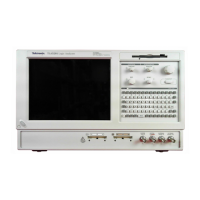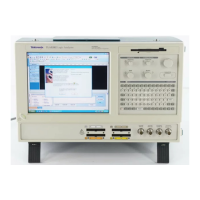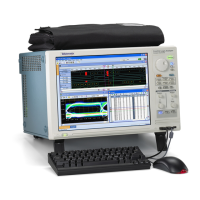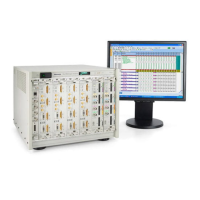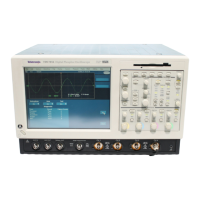Theory of operation
Improving measurement accuracy
DSP correction filtering
P7700 Series probes and probe tips use DSP correction filtering to optimize probe
measurement fidelity. High frequency time domain measurement performance
characteristics such as rise time, aberrations, and pulse fl atness are improved by
DSP correction filtering. Similarly, frequency domain performance characteristics
such as band
width, frequency response flatness, and differential signal coupling
areimprovedbyDSPcorrectionfiltering. DSP correction filtering is performed
automatically by the oscilloscope using S-parameter characterization data
downloaded from probe and probe tip storage memories. This S-parameter data is
unique for each probe a nd probe tip, rather than the nominal response data that
was used in some previous generation probe families.
Distinct S-parameter data sets are stored in probe memory for each probe input
mode and step gain setting combination. Every different input mode and step gain
combina
tion has a slightly different amplifier signal path, which requires different
signal response correction. Since the solder tip buffers do not have complex mode
switching, only one S-parameter data set is stored in the probe tip storage memory.
The high frequency signal performance of the P77BRWSR browser tip changes
slightly as the tip spacing is adjusted. Several S-parameter data sets are stored
in the browser tip memory and automatically switched to the optimum data set,
unde
r control of the browser tip spacing position detection circuitry.
S-parameter characterization data are measured for each probe and probe tip as
part
of the manufacturing test process. P7700 Series p robe signal performance is
measured using a 3-port VNA measurement configuration with a 2-port TekFlex
connector input and a 1-port TekConnect interface output. Custom test fixtures
have been developed for making VNA port connections to the probe TekFlex
connector input and TekConnect interface output. Test fixtures designed for
connecting to the probe input and output signal ports are de-embedded to remove
i
nterconnect losses and signal path imperfections.
P7700 Series probe tip signal performance is measured using a 4-port VNA
m
easurement configuration with 2-port input and output connections. Because
the P7700 Series probe tips do not have standard RF connectors at their inputs
or outputs, the custom test fixtures inject and receive VNA port signals. Custom
calibration standards were developed to support de-embedding these probe tip
manufacturing test fixtures.
P7700 Series TriMode Probes Technical Reference 21

